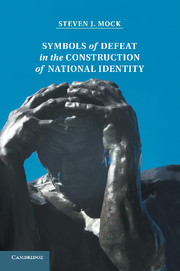Book contents
- Frontmatter
- Contents
- Acknowledgments
- Introduction
- 1 Theories of Nations and Nationalism
- 2 Totem Sacrifice and National Identity
- 3 Symbols of Defeat in National Monument and Ritual
- 4 The Defeat Narrative in National Myth and Symbol
- 5 Implications to Politics and Diplomacy
- 6 Exceptions
- Conclusions
- Bibliography
- Index
3 - Symbols of Defeat in National Monument and Ritual
Published online by Cambridge University Press: 05 January 2012
- Frontmatter
- Contents
- Acknowledgments
- Introduction
- 1 Theories of Nations and Nationalism
- 2 Totem Sacrifice and National Identity
- 3 Symbols of Defeat in National Monument and Ritual
- 4 The Defeat Narrative in National Myth and Symbol
- 5 Implications to Politics and Diplomacy
- 6 Exceptions
- Conclusions
- Bibliography
- Index
Summary
The preceding chapter identified four distinct but related explanations as to why a nation might elevate an image of defeat to the center of its mythology:
Such symbols substantiate the connection between the modern nation and a primordial past, at the same time providing a ready explanation for the nation's “dormition” in the intervening time.
They offer a conception of the nation as durable if not indestructible, able to persevere through even the worst of disasters.
Focus on a moment of historical injustice makes rectification of that injustice a motive to justify national mobilization.
Myths and symbols of defeat also serve a ritual function, resolving an ambivalence that members of the nation feel first toward the constraints imposed by social order itself and then toward their own ethnic heritage, which is relied on for the society's symbolic content but represents a form of order that must be rejected and transcended in the modern world.
To substantiate this argument empirically, we should be able to locate and recognize these functions in varying expressions of national myth, as well as in the norms and ritual affirmations of the nation. However, it is important to note that operating within the register of Freudian theory demands caution in avoiding certain standard Freudian pitfalls. Any attempt to empirically verify a theory that employs concepts such as ambivalence and repression runs the risk of falling into circular reasoning. Simply put, repression amounts to the need to hide something from oneself. On the level of a society, a collective dynamic of repression will occur when the structure of the social order compels those who submit to it to repress the same thing in the interests of maintaining that order. In other words, we are, by definition, looking for contradictory evidence. We are seeking that which is hidden from view and the mechanisms employed to hide it. In which case it becomes all too easy to dismiss behaviors or texts that do not appear to manifest the theorized dynamic as examples of mechanisms by which the dynamic is repressed from consciousness.
- Type
- Chapter
- Information
- Symbols of Defeat in the Construction of National Identity , pp. 92 - 154Publisher: Cambridge University PressPrint publication year: 2011



